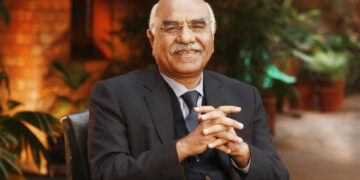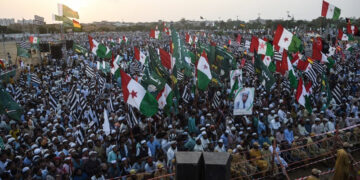 The NATO/US decision to withdraw from Afghanistan is as momentous as was the decision to launch the attack on Afghanistan on October 7, 2001. Like the 2001 decision, the implications of the latest decision go far beyond Afghanistan.This announcement has shifted the focus away from July 2011 when the US is supposed to start withdrawing its troops from Afghanistan. The withdrawal of the troops may or may not start or the US may undertake a token withdrawal. What matters most is not July 2011 but the run up to the ultimate withdrawal date, i.e. December 2014. What kind of steps will NATO and the US undertake over the next four years to implement their commitment?There are three constituent elements of the withdrawal decision: training of the Afghan National Army and the police that will be assigned internal security responsibilities, enhancement of administrative capacity of the Kabul government and decentralisation of authority to the district level, and the weakening of the war machine of the Taliban to the extent that their determination to fight is sapped and some of them seek peace through negotiations.
The NATO/US decision to withdraw from Afghanistan is as momentous as was the decision to launch the attack on Afghanistan on October 7, 2001. Like the 2001 decision, the implications of the latest decision go far beyond Afghanistan.This announcement has shifted the focus away from July 2011 when the US is supposed to start withdrawing its troops from Afghanistan. The withdrawal of the troops may or may not start or the US may undertake a token withdrawal. What matters most is not July 2011 but the run up to the ultimate withdrawal date, i.e. December 2014. What kind of steps will NATO and the US undertake over the next four years to implement their commitment?There are three constituent elements of the withdrawal decision: training of the Afghan National Army and the police that will be assigned internal security responsibilities, enhancement of administrative capacity of the Kabul government and decentralisation of authority to the district level, and the weakening of the war machine of the Taliban to the extent that their determination to fight is sapped and some of them seek peace through negotiations.
The outcome of these elements will be decisive in determining if the withdrawal will materialise. This will also shape the political and military situation in Afghanistan in the days after the NATO/US withdrawal.The optimistic scenario is that the allied forces will be able to create a professional and well-trained Afghan army that will take up internal security responsibilities and fight the remnants of the Taliban. A well-trained police force will also be available to take care of the security and law and order situation in the cities and reinforce the district administration to assert its authority. By the end of 2014, the Afghan army and the police will replace the US and NATO security forces.The pessimistic scenario is that NATO and the US are unable to train the Afghanistan National Army and the police in sufficient numbers to assume security responsibilities. Their large-scale systematic training was initiated over one year ago and, so far, no unit of the Afghan army is in a position to face the Taliban all by itself. The Afghan police and the army lack a professional disposition and the desertion rate is high. This state of affairs is not expected to change. The US and NATO will continue to stay on but if they leave in a hurry, the Taliban will overwhelm the Afghan army and the police. There is no honourable exit for the allied troops.The US is expected to start experimenting with the transfer of responsibility to selected districts in 2011 to see if the Afghan administration, the army and the police can manage their affairs without direct American or NATO involvement. The outcome of these experiments will be used to make mid-course corrections in the plan for the ultimate withdrawal. The training process will also be revised accordingly.
The most likely scenario is that there will be enough numbers in the Afghan army and the police to takeover internal security responsibilities and the US and NATO will gradually withdraw their troops by the end of 2014. However, they will maintain 20,000 to 25,000 troops in Afghanistan for a training and advisory role. These troops may also serve as a backup force for the Afghan army. Afghanistan can retain some American troops under a treaty arrangement. The Afghan needs will be shaped by the extent of success of the NATO/US troops in undermining the Taliban war machine by 2014 and winning over some of them to their side.The allied troops need a major military success against the Taliban in the first quarter of 2011 to undo the current perception that the Taliban are entrenched and the allied and Afghan troops lack the required determination to dismantle the Taliban resistance. The current security perception in Afghanistan favours the Taliban, which needs to be reversed as early as possible.The immediate impact of the announcement of the withdrawal plan is the increased American pressure on Pakistan to launch military operations against the Afghan Taliban based in the tribal areas, especially in North Waziristan, and the Taliban activists located in the vicinity of Quetta in Balochistan. The general perception in official and non-official circles in Washington is that unless the ‘safe havens’ of the Afghan Taliban are dismantled in Pakistani territory, the allied troops cannot succeed. This appears to be a single-issue obsession with the American authorities without taking into account the problems of the Pakistan Army currently busy with counter-insurgency in many parts of the tribal areas and other constraints of policy making and implementation in Pakistan.
There is another dimension of withdrawal politics. President Hamid Karzai wants to ensure his centrality to the withdrawal process and the subsequent period. He wants all negotiations with the Taliban to be processed through his administration so that the US is not in a position to sideline or remove him as part of the political arrangements for the post-withdrawal period.It is difficult to predict how far Hamid Karzai can influence American efforts to his advantage or coordinate with Pakistan in the run up to the withdrawal because he hardly trusts anyone beyond his very close circle. Both Pakistan and the present Afghan leadership will have to contend with regional states like Iran, Russia and India, who have a strong interest in what happens in Afghanistan.Pakistan faces an additional problem. There are about three million Afghans living in Pakistan as refugees or otherwise. Most of them are expected to be polarised if internal strife surges in Afghanistan. The same can be said about the activists among Pakistani Pakhtuns who are concerned about the developments in Afghanistan and Pakistan’s tribal areas.
Pakistan’s security bosses need to articulate their vision of the future of Afghanistan as a friendly state whose economy is linked with Pakistan. They should find a realistic balance between their desire for a commanding role in and around Afghanistan and the dynamics of global and regional power politics. A stable Afghanistan will enable them to address Pakistan’s internal problems in a more effective manner.The implementation of the withdrawal decision and stabilisation of Afghanistan can be facilitated if the US, the present Afghan government and Pakistan evolve a shared approach through mutual consultation and accommodation. This will reduce interference by other states – Dailytimes – Dr Hasan Askari Rizvi
|
ANALYSIS: Withdrawal from Afghanistan —Dr Hasan-Askari Rizvi
The NATO/US decision to withdraw from Afghanistan is as momentous as was the decision to launch the attack on Afghanistan on October 7, 2001. Like the 2001 decision, the implications of the latest decision go far beyond Afghanistan. This announcement has shifted the focus away from July 2011 when the US is supposed to start withdrawing its troops from Afghanistan. The withdrawal of the troops may or may not start or the US may undertake a token withdrawal. What matters most is not July 2011 but the run up to the ultimate withdrawal date, i.e. December 2014. What kind of steps will NATO and the US undertake over the next four years to implement their commitment? There are three constituent elements of the withdrawal decision: training of the Afghan National Army and the police that will be assigned internal security responsibilities, enhancement of administrative capacity of the Kabul government and decentralisation of authority to the district level, and the weakening of the war machine of the Taliban to the extent that their determination to fight is sapped and some of them seek peace through negotiations. The outcome of these elements will be decisive in determining if the withdrawal will materialise. This will also shape the political and military situation in Afghanistan in the days after the NATO/US withdrawal. The optimistic scenario is that the allied forces will be able to create a professional and well-trained Afghan army that will take up internal security responsibilities and fight the remnants of the Taliban. A well-trained police force will also be available to take care of the security and law and order situation in the cities and reinforce the district administration to assert its authority. By the end of 2014, the Afghan army and the police will replace the US and NATO security forces. The pessimistic scenario is that NATO and the US are unable to train the Afghanistan National Army and the police in sufficient numbers to assume security responsibilities. Their large-scale systematic training was initiated over one year ago and, so far, no unit of the Afghan army is in a position to face the Taliban all by itself. The Afghan police and the army lack a professional disposition and the desertion rate is high. This state of affairs is not expected to change. The US and NATO will continue to stay on but if they leave in a hurry, the Taliban will overwhelm the Afghan army and the police. There is no honourable exit for the allied troops. The US is expected to start experimenting with the transfer of responsibility to selected districts in 2011 to see if the Afghan administration, the army and the police can manage their affairs without direct American or NATO involvement. The outcome of these experiments will be used to make mid-course corrections in the plan for the ultimate withdrawal. The training process will also be revised accordingly. The most likely scenario is that there will be enough numbers in the Afghan army and the police to takeover internal security responsibilities and the US and NATO will gradually withdraw their troops by the end of 2014. However, they will maintain 20,000 to 25,000 troops in Afghanistan for a training and advisory role. These troops may also serve as a backup force for the Afghan army. Afghanistan can retain some American troops under a treaty arrangement. The Afghan needs will be shaped by the extent of success of the NATO/US troops in undermining the Taliban war machine by 2014 and winning over some of them to their side. The allied troops need a major military success against the Taliban in the first quarter of 2011 to undo the current perception that the Taliban are entrenched and the allied and Afghan troops lack the required determination to dismantle the Taliban resistance. The current security perception in Afghanistan favours the Taliban, which needs to be reversed as early as possible. The immediate impact of the announcement of the withdrawal plan is the increased American pressure on Pakistan to launch military operations against the Afghan Taliban based in the tribal areas, especially in North Waziristan, and the Taliban activists located in the vicinity of Quetta in Balochistan. The general perception in official and non-official circles in Washington is that unless the ‘safe havens’ of the Afghan Taliban are dismantled in Pakistani territory, the allied troops cannot succeed. This appears to be a single-issue obsession with the American authorities without taking into account the problems of the Pakistan Army currently busy with counter-insurgency in many parts of the tribal areas and other constraints of policy making and implementation in Pakistan. There is another dimension of withdrawal politics. President Hamid Karzai wants to ensure his centrality to the withdrawal process and the subsequent period. He wants all negotiations with the Taliban to be processed through his administration so that the US is not in a position to sideline or remove him as part of the political arrangements for the post-withdrawal period. It is difficult to predict how far Hamid Karzai can influence American efforts to his advantage or coordinate with Pakistan in the run up to the withdrawal because he hardly trusts anyone beyond his very close circle. Both Pakistan and the present Afghan leadership will have to contend with regional states like Iran, Russia and India, who have a strong interest in what happens in Afghanistan. Pakistan faces an additional problem. There are about three million Afghans living in Pakistan as refugees or otherwise. Most of them are expected to be polarised if internal strife surges in Afghanistan. The same can be said about the activists among Pakistani Pakhtuns who are concerned about the developments in Afghanistan and Pakistan’s tribal areas. Pakistan’s security bosses need to articulate their vision of the future of Afghanistan as a friendly state whose economy is linked with Pakistan. They should find a realistic balance between their desire for a commanding role in and around Afghanistan and the dynamics of global and regional power politics. A stable Afghanistan will enable them to address Pakistan’s internal problems in a more effective manner. The implementation of the withdrawal decision and stabilisation of Afghanistan can be facilitated if the US, the present Afghan government and Pakistan evolve a shared approach through mutual consultation and accommodation. This will reduce interference by other states. The writer is a political and defence analyst |












